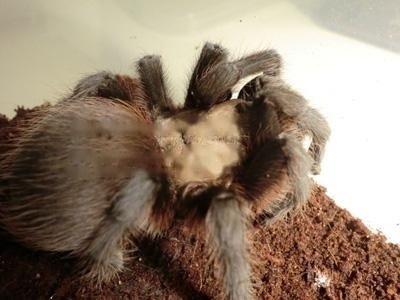
Texas Brown Tarantula
Adult body length is 13-14 cm, suitable temperature is 28-30 ℃, and suitable humidity is 65%. It is recommended to use moist peat, coconut brick and clay as the substrate. It tak
English name: Brazilian Red and White Bird Eater
Origin: Eastern Brazilian Rainforest
Brazilian white red tailSpider (Latin scientific name: Nhandu chromatus), also known as the Brazilian red and white bird-eating spider, is native to the tropical rainforest of eastern Brazil, classic Pets is one of the species of tarantulas, but it is also a species that is gradually declining in popularity among breeders. Similar in appearance, but larger and more docile, the Brazilian White Knee has been chosen more often. Although these tarantula species native to Brazil have long been protected by the authorities, any smuggling is impossible today. Fortunately, the individuals smuggled out earlier in the year were successfully bred under captivity, and they produced very small but very large offspring, so they were enough to supply the entire pet tarantula market.
Brazilian red-tailed spider, vicious, terrestrial, 17~20cm. Likes to eat crickets, and occasionally can feed newborn white mice (that is, RS: suckling mice), suitable temperature: 26-28 degrees; suitable humidity: 80%.
Chinese name: Brazilian white-tailed tarantula
Latin name: Nhandu chromatus
Alternative name : Brazilian red-and-white tarantula
Kingdom: Animalia
Department: Arthropoda
Subphylum: Chelipoda
Class: Arachnida
Subclass: Stembelly
Order: Arachnida
Suborder : Prototheca
Family: Tarantidae
Genus: Nhandu
Species: Brazilian white striped birdeater
English: White striped birdeater
Reproduction: Oviparous
Physical features: 17~20cm
Appearance characteristics of Brazilian red-tailed spider
larvae Rearing:
Well, have you rested? Then crush the mealworm's head, cut it into small sections and put it in. It can be placed before dodging, shake it with tweezers, and tempt spider Come out to hunt. You can also get a little sap from the mealworms to lure the spiders with their scent.
Remember! Don't feed too much! Don't feed live before 2 cm!
You can feed larvae once every 3 days, sub-adults and adults once every five days, and adults can also be fed every seven days once.
Moulting (why are so many people beaten to peeling - -) before the butt will turn black, this is common sense, so you don't have to worry when you find that the white buttocks are black, this is a precursor to shedding Yo~ You can stop feeding at this time. After molting, you can give it a big meal. After all, the spiders show you a strip show and you need consolation~
Generally, the larvae molt once a month. Adult half a year, adult half a year to a year. Shiraima is a relatively fast species, so I don't have to worry about the question of "Will my spider grow very slowly?".
Sub-adult & adult feeding:
This is simple ~ put food, sub-adult eats three in one meal, how much can the adult eat Eat as much as you want, don't feed when your stomach is big, be careful to die!
The environment for adults and sub-adults can be replaced with larger ones. A reptile box.
At this time, I can make landscaping. I planted some soft-haired cacti (you can go to the flower market to search for them, they are soft and cute) and some unknown flowers, and then put a piece of bark and water. plate, put sponge in it, it's OK. If you like landscaping, you can take a little extra effort. Go to the sky to see where the spiders make landscaping. There are many beautiful landscaping by seniors.